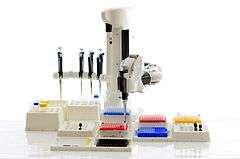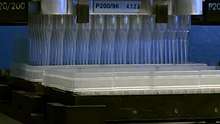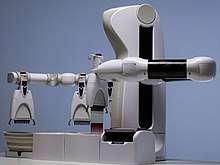Liquid handling robot
A liquid handling robot is used in automation of chemical or biochemical laboratories. It is a robot that dispenses a selected quantity of reagent, samples or other liquid to a designated container.



Versatility
The simplest version simply dispenses an allotted volume of liquid from a motorized pipette or syringe; more complicated machines can also manipulate the position of the dispensers and containers (often a Cartesian coordinate robot) and/or integrate additional laboratory devices, such as centrifuges, microplate readers, heat sealers, heater/shakers, bar code readers, spectrophotometric devices, storage devices and incubators.
More complex liquid handling workstations can perform multiple Laboratory Unit Operations such as sample transport, sample mixing, manipulation and incubation, as well as transporting vessels to/from other workstations.
They can range from a specialized bench-top 8-channel DNA PCR processing robot, to a customized-for-process automated liquid handling system, such as the TECAN Freedom EVO (shown on the right), the HighRes Biosolution's PRIME and Janus Automated liquid handlers from PerkinElmer. Other liquid handling systems are designed for specific experiments, e.g. the Intavis InsituPro robot for the automation of immunohistochemistry and in situ hybridization on whole-mounts and slides.
An alternative category of liquid handlers mimics the operations of humans, by performing liquid transfers as humans would do. These robots achieve the cartesian, 3-axis movements implemented in larger workstations, by means of an arm. Anthropomorphic robots better integrate into laboratories designed for manual pipetting operations, since they can strictly reproduce the pipetting procedures adopted by humans. In some cases (like the "Andrew" system shown on the right[1] ) they can even use the same pipettes and consumables, being based on camera-based vision algorithms like those implemented in modern domotics and robotics developments.
Modularity
Liquid handling robots can be customized using different add-on modules such as centrifuges, PCR machines, colony pickers, shaking modules, heating modules and others. Some liquid handling robots utilize Acoustic Liquid Handling which uses sound to move liquids without the traditional pipette or syringe.
Control Software
Control software, either on a connected computer, or integrated into the system itself, allows the user to customize the liquid handling procedures and transfer volumes.
References
- Hands-free use of pipettes, October 2012, retrieved September 30, 2012